How to treat the decline in textile and apparel exports?
According to data released by the General Administration of Customs, China's imports and exports in May fell year-on-year in terms of US dollars. Among them, textiles and apparels also showed a significant decline, which was greater than that of the average total exports.
| China's exports in Jan-May, 2022/2023 (million USD) | ||||
| Item | Period | 2023 | 2022 | Y-O-Y change |
| Total export | May | 283,500 | 308,240 | -8.0% |
| Jan-May | 1,400,350 | 1,402,570 | -0.2% | |
| Textile | May | 12,021.8 | 14,028.2 | -14.3% |
| Jan-May | 56,829.1 | 62,719.2 | -9.4% | |
| Apparel | May | 13,298.4 | 15,199.2 | -12.5% |
| Jan-May | 61,373.4 | 62,052.2 | -1.1% | |
Source: China Customs
*Note: The year-on-year increase or decrease is calculated based on the absolute value announced during the same period, which is different from the year-on-year data directly announced by the customs.
China is a major textile and apparel manufacturing and exporting country, with the capacity accounting for more than half of the world's total, with some taking up more than 70%. The decline in exports will obviously drag down the recovery of textiles and apparels. So, what is the current status of China's exports? How will it change in the future?
The main destinations of China's textile and apparel exports are the US, EU, ASEAN, and Japan, occupying more than 50% of the total exports.
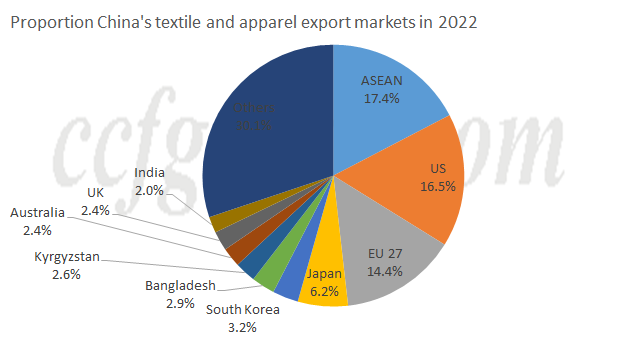
Among the four destinations, the US, EU, and Japan have a tendency of de-sinicization their industrial chains, while ASEAN shows significant growth.
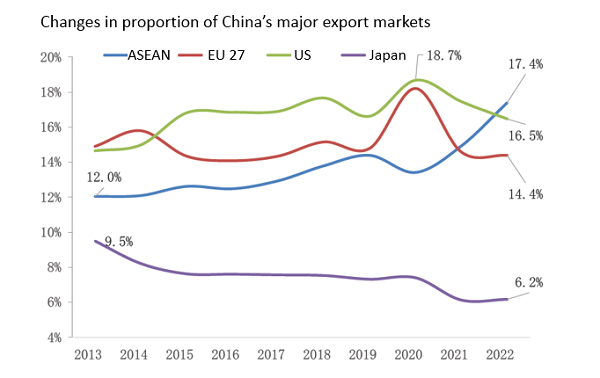
In fact, apart from de-sinicization factors, the decline in global demand is the main reason. Taking Vietnam as an example, the apparel exports also fell by 16.6% in the first two months of this year. Although the latest data has not been acquired, according to the survey, apparel processors still reflect a decrease in orders. As for demand, taking the United States as an example, the significant decrease in the import volume is largely due to the excessive inventory of its apparel wholesalers. Based on apparel and fabric inventory tracking for US wholesalers, we can clearly find that the inventory of US wholesalers in 2022 increased abnormally. By 2022, the inventory of US wholesalers had reached 42.991 billion US dollars, which is more than 60% higher than the average level of 25 billion US dollars. At the same time, the reports of many listed apparel companies also showed that the inventory was abnormally high. The high inventory of apparels in European and American countries is the main reason for the decrease in apparel exports from Asian countries this year.
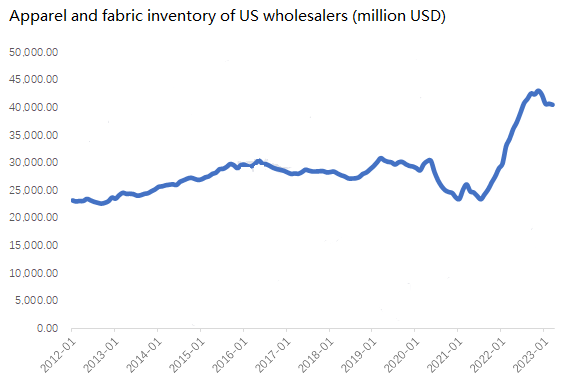
The increase in inventory is certainly related to factors such as the epidemic, inflation, and consumption fluctuations. But to a large extent, it is also an inevitable pain point of the traditional apparel processing and sales model.
The traditional apparel processing and sales model is mainly for brand owners to predict demand trends, and then place orders for production. After the apparels are produced and delivered to brand owners, brand owners will hold a large amount of inventory and wait for choices from the consumers. In this model, brand owners are the drivers of the entire chain, especially for the upper-end supply chain. But for consumption, the control of brand owners is not very strong. In fact, it is difficult to predict the overall change in consumption. The fluctuation is often greater than the supply of brand owners, and tidal phenomena will occur to some extent. This will easily lead to a certain stage of bestselling apparels, while a backlog of inventory in another stage. During the best-selling period, the brand owners will make huge profits, which also made Inditex founder-Amancio Ortega the world's richest man, and Shein founder-Xu Yangtian topped the 2023 "New Fortune Top 500 Rich List" as the richest man in Guangzhou. In the depression period, many brand owners were shuffled out because of wrong bets on inventory.
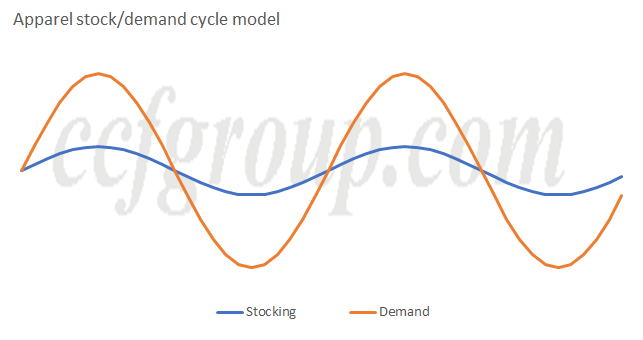
According to the most traditional apparel supply chain management, even if the logistics cycle is disregarded, the orders need to be placed two months or more in advance so that the demand can be satisfied when the consumption season comes. This means that brand owners may have to bear more than two months of apparel inventory. If considering the apparels that were not fully sold earlier, the inventory cycle of brand owners is usually more than 6 months, or even one year.
With the rise of fast fashion brands in the past decade, the cycle has been greatly shortened to 14-60 days. The inventory cycle of these fast fashions is generally lower than that of traditional brands. However, the model is still "determining sales based on production". As long as this model exists, high inventory fluctuations in apparels cannot be avoided.
The emergence of digital new manufacturing has changed this to a large extent. At present, the better performance in this area is made by Rhino Intelligent Manufacturing in China. Relying on a huge platform and massive retail data and retailers, the company can achieve the goal of production based on sales to a certain degree. A large amount of retail data can better grasp the consumption trend and carry out small batch production with very low risk.
In the manufacturing process, Rhino Smart Manufacturing, a new digital factory, can compress the processing of many basic apparel items to less than 7 days, and has created a miracle of delivering orders in 3 days. According to the current general rules of internet apparel sales in China, it is in line with the requirements of most platform rules for retailers to deliver goods within 14 days after consumers place an order.
According to the efficiency of Rhino Smart Manufacturing, it is possible to process the apparels after the orders are placed. This theoretically can achieve zero inventory of apparel inventory, or even negative inventory.
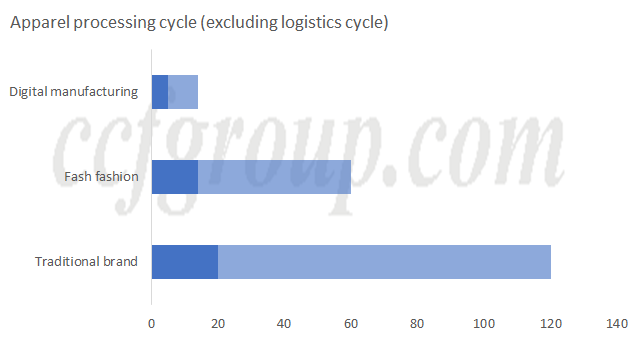
Of course, this requires extreme digital processing capabilities, as well as the automation of production efficiency and the ultimate improvement of management. At present, Alibaba Xunxi (Hangzhou) Digital Technology Co., Ltd. is the only lighthouse factory in the textile and apparel field certified by the Davos World Economic Forum, which is the so-called standard Industry 4.0 enterprise. The company not only has advanced production concepts, but also has the output capability of digital operation. At present, Rhino Intelligent Manufacturing has transformed some other world-class factories in China and has undertaken a large number of orders from the platform.
In order to fully change the traditional apparel supply chain model, it is not enough to rely on a few advanced enterprises at present, and it is necessary to create an efficient apparel supply chain ecology.
If an efficient apparel digital supply chain ecology can be built in the future, it is foreseeable that the inventory of apparel enterprises will drop significantly, and the fluctuation of supply chain demand will be narrowed. The export volatility of some processing countries will also be reduced accordingly. Of course, as a consumer product, fluctuations will always exist, and the roles and opportunities of different links in the supply chain will be different in this process.
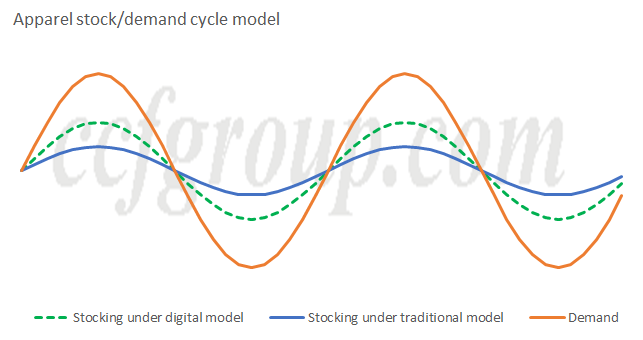
Based on this judgment, CCFGroup has recently cooperated with Rhino Smart Manufacturing (Alibaba Xunxi (Hangzhou) Digital Technology Co., Ltd.) to host the 1st China Digital E-commerce Summit of Textile & Apparel, aiming to share the digital process and commercial value with more upstream manufacturers in the industry chain, and explore ways to participate and try to build a business ecosystem.
- Top keywords
- Cotton Price
- Cotton Futures Price
- Cotton Futures
- CZCE
- PTA Futures Price
- Chemical Fiber
- Polyester Prices
- Wool price
- PTA Futures
- Shengze Silk
- China
- Yarn Price
- price
- China Textile City
- Fibre Price
- Benzene Price
- Cotton
- Index
- Cotton Index
- PTA
- fabric price
- NYMEX
- Top 10
- textile industry
- Spot Cotton
- Cotton Yarn
- Polyester Price
- Futures
- PTA Price
- cotton yarn price

